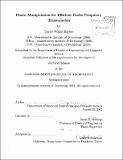Phase manipulation for efficient radio frequency transmission
Author(s)
Barton, Taylor Wallis
DownloadFull printable version (9.572Mb)
Other Contributors
Massachusetts Institute of Technology. Department of Electrical Engineering and Computer Science.
Advisor
James K. Roberge.
Terms of use
Metadata
Show full item recordAbstract
Power amplifiers (PAs) for microwave communications are generally the most power-hungry element of a transmitter. High linearity is required for modern digital communications standards, and often is achieved at the expense of efficiency. Outphasing architectures, which combine multiple nonlinear but efficient switching PAs into a system with an overall linear response, represent a promising strategy for breaking the efficiency/linearity tradeoff inherent to conventional PAs. This work explores methods for efficient PA design using outphasing techniques. Two aspects of outphasing design are considered. First, a wide-band phase modulator is introduced that uses a single current-steering digital to analog converter (DAC) structure and discrete clock prerotation. This topology takes advantage of specifications particular to outphasing architectures to reduce matching requirements as compared to a two-DAC phase modulator while providing wideband capability. The phase modulator is demonstrated in 65-nm CMOS, operates over a carrier frequency range of 1.2-4.2 GHz and has a 12-bit phase resolution and sample rate of 160 MSamples/second. The second technique is a novel four-way lossless power combiner and outphasing system which provides ideally lossless power combining along with resistive loading of switching power amplifiers over a wide output range. This work presents the first-ever demonstration of this system at microwave frequencies. Particular attention is paid to the microwave-specific aspects of implementation. A 60-W GaN prototype demonstrates the outphasing and dynamic performance, which closely matches the expected performance despite the challenges of operating at microwave frequencies.
Description
Thesis (Sc. D.)--Massachusetts Institute of Technology, Dept. of Electrical Engineering and Computer Science, 2012. Cataloged from PDF version of thesis. Includes bibliographical references (p. 109-112).
Date issued
2012Department
Massachusetts Institute of Technology. Department of Electrical Engineering and Computer SciencePublisher
Massachusetts Institute of Technology
Keywords
Electrical Engineering and Computer Science.